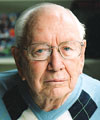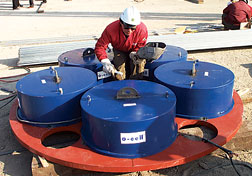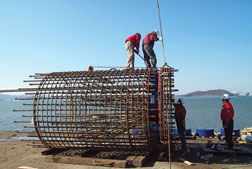 |
| OSTERBERG |
Twenty years ago, deep foundation work was forever transformed with the advent of the Osterberg Cell. Named after its inventor, Jorj O. Osterberg, this hydraulically driven bi-directional sacrificial load cell was the first practical and economical method to measure the full bearing capacity of a shaft.
Comprised of a piston and pressure chamber, the O-cell is mounted between two bearing plates and cast into concrete at the bottom of a shaft. It is pressurized internally, creating equal upward and downward loads that can independently determine side-shear and end-bearing capacity of bedrock and/or soil. Measurements are logged and plotted by computer. Multiple O-cells between plates can increase testing capacity and the O-cell can also be used on driven piles, auger cast piles and barrettes.
“It was the right test at the right time,” says John R. Roma, vice president of Raito Inc., Woburn, Mass. “It came out just when greater use of drilled shafts was pushing uncharted territory in design values due to larger sizes and depths. The O-cell was the design engineer’s dream.”
“Prior to the O-cell, development of design parameters was derived from field and laboratory tests or small-scale testing, which isn’t considered as reliable,” adds Mark X. Haley, senior vice president of Haley & Aldrich, Boston.
Osterberg, former professor emeritus of civ-il engineering at Northwestern University, now is retired and living in Denver. His doctoral dissertation discussed the use of diaphragms and an interferometer for testing of pressure or load. “When you look at conventional load testing and all the problems it presented in terms of space, physical risk, logistics and measurement, there had been a need for innovation,” says Osterberg. “The first prototypes had walls that were made with accordion-type bellows. These were difficult to make and the theoretical loads were difficult to estimate. After finding reliable seals and the use of good materials, the cell is now based on a piston within a cylinder.”

Loadtest
|

Loadtest
Widespread use of Osterberg cells has helped to reduce design uncertainty and foundation costs.
|
John H. Schmertmann, who studied under Osterberg 50 years ago, recalls that Osterberg had been working on the O-cell since 1984 and patented the idea in 1987. He then started working with Charles L. Guild at his firm, American Equipment & Fabricating Corp, East Providence, R.I., to further develop the device.
“Jorj was having a hard time getting his ideas accepted by other engineers,” says Schmertmann. “Then David K. Crapps and I used the O-cell on a large bridge job near Daytona, Fla. That was a bit of a breakthrough. It was a large drilled shaft on an important project and the results were relied upon." Osterberg, Guild, Crapps, Schmertmann and J. A. (Jack) Hayes then started Loadtest Inc., in 1991 to exclusively market and distribute the cell and provide engineering services. The cell is manufactured by AEF.
Schmertmann notes the current O-cell test record is 63,000 kips in 2005 on a 10-ft diameter, 220-ft shaft for the Incheon Bridge in South Korea. “Prior to the O-cell, the maximum load I ever heard of was 9,000 kips,” he says. “But the O-cell is essentially unlimited because it is encapsulated in concrete. There are no safety issues.”

Post a comment to this article
Report Abusive Comment